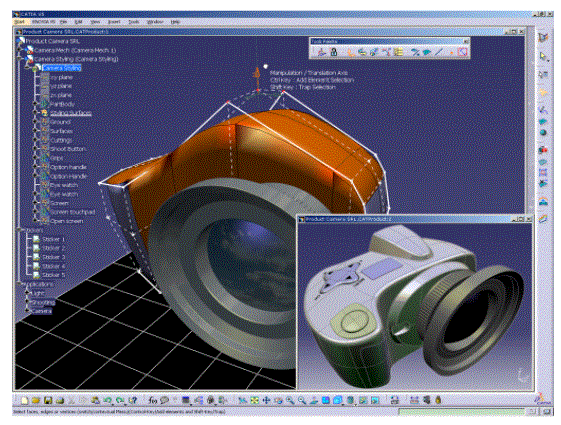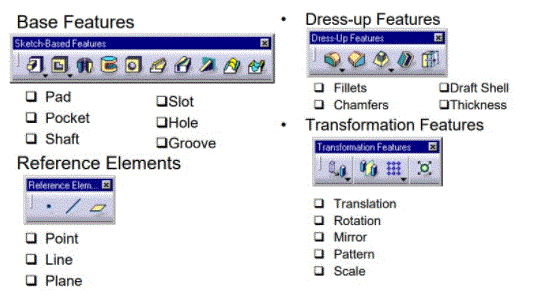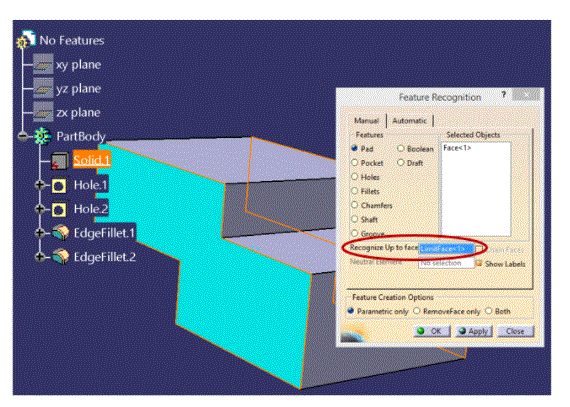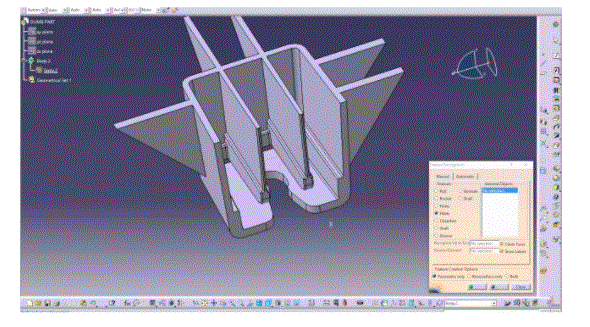
CATIA is the product design software developed and created by Dassault Systemes. The software is commonly used in manufacturing industries and Original Equipment Manufacturers (OEMs) to increase designing, analyzing, and managing new products.
- Introduction to Catia
- Catia History
- Features of Catia
- How does Catia make working so easy?
- What can you do with Catia?
- Working with Catia
- Why should we use Catia?
- Catia Scope
- Benefits of Catia
- Conclusion
Introduction to Catia:
Catia stands for pc Aid Three-Dimensional Interactive Application. it’s rather more than CAD (Computer assisted Design) computer code. It’s an entire computer code that mixes CAD, CAE (Computer-Aided Engineering) and CAM (Computer-Aided Engineering).
So, let’s take a glance at every of those areas and therefore the tools Catia provides professionals to market innovation in development. Enables 2nd and 3D style
Computer assisted style is widely employed by Developers to help in making, modifying and / or analysing graphic representations of product styles. Its use extends several|to several} industries due to its many noted edges.
The development of CAD computer code continues to boost style quality with larger accuracy and cut back style errors. CAD computer code is additionally capable of rising communication because of the centralization of style knowledge and documentation, making one true supply for developers and makers.

Catia History:
Catia began as an inside development in 1977 by French craft manufacturer Avions Marcel Dassault to supply heaps of 3D modelling and NC functions for the CADAM package they were exploiting at the time [4] to develop the Mirage plane. Originally renamed CATI (conception assistée tridimensionnelle interactive – French for interactive aided three-dimensional design), it had been renamed Catia in 1981 once Dassault created a subsidiary of Dassault Systèmes to develop and sell packages, to a lower place management. of its initial business executive, Francis biologist. Dassault Systèmes has signed a contract under seal with IBM, [5] that has to boot commercial CADAM for Lockheed since 1978. Version one was discharged in 1982 as a supplement to CADAM.
During the eighties Catia saw widespread discovery among the aviation and military industries with users like Boeing and General Dynamics electric Boat business. Dassault Systèmes bought CADAM from IBM in 1992, and thus the subsequent year Catia CADAM was discharged. throughout the nineties Catia was initial place in in 1996 from one to four OS applications, and was totally rewritten in version 5 in 1998 to support Windows NGO. [9] among the years before 2000, this created problems with inconsistencies between versions that semiconductor unit to $ six.1B in any costs due to delays in production of the aeroplane A380.
Features of Catia:
Punished system
Catia takes a more disciplined approach when focusing on product development and design. It looks at specific needs from different sectors to help companies develop and update new products.
Sketching and Rendering Technology
Users can access a variety of tools that offer the ability to explore and design new ideas. With Catia’s flexible 3D drawing functionality, users can submit 2D drawings and generate new design ideas. Designers who want to enhance visual knowledge can create quality offerings by using global light as well as streamlining shadows and displays.
Engineering ideas
Catia can help engineers improve their data by looking at factors that affect the quality and overall performance of their products with its 3D modelling tools. They are given the freedom to perform analysis and to create automated products within their workplaces by simulation, prototyping, and complete analysis.
Multi-Field Development
The forum provides architects, developers, and engineers a combination of validation, multi-modal modelling, and business processing support. Catia provides users with flexibility by allowing them to integrate 3D processes with embedded systems to create advanced simulations of complex products and systems.
Compliance with Markets
Catia engineering requirements ensure that engineers will adhere to their marketing rules and requirements while minimising costs in both system and product development.
Effective Interaction
The collaborative 3D environment of the tool allows participants and users to actively participate in the design process. Such a location can be accessed by 3D dashboards while serving as a virtual model.

How does Catia make working so easy?
It combines the Multidisciplinary approach with the Cross-Discipline Development Platform. With an amazing 3D user experience and easy workflow, as well as a Community Design Area, It makes working easier and easier. It is based on the Advanced Surface Modelling structure and has an Infinite Relationship design.
Allows users to create a Product Model based on their real-life behaviour. It also assists in the construction of power, electrical, and distribution systems. In addition, the graphical user interface is relatively easy to use compared to other 3D programs. Each tool and command in the workplace is clear and easily accessible.
- Used to develop Indian Light Combat Aircraft.
- Also used on European Aerospace Airbus.
- BAE Systems uses Catia.
- P3 Voith uses Catia V6.
What can you do with Catia?
It is widely used in its targeted system, drawing and rendering technology, multi-platform development, market compliance, engineering specifications, and operational collaboration. It is widely used by a variety of industries. These industries are automotive, aerospace, defence and industrial equipment, plant design, consumer goods, construction and construction, processing capacity, fuel, and other resources.
The aerospace industry, Catia is used for the following:
Catia is a great app and can be read by anyone interested in product design, 3D architecture, 3D digital mockup, and users interested in the development and creation of new products. The software incorporates a variety of ways to design and develop products that allow users to use advanced updates and tools. It works well for program designers, engineers, and industrial designers.
This technology is different from other software, and it offers advanced but simple tools and instructions. The skills it teaches will benefit users to gain knowledge and experience and help them improve their careers and future prospects.
Working with Catia:
It is a robust software package program, and it should take your time for you to master the system. Being an excellent program, it’s tough to use however at an equivalent time terribly helpful for several functions.
Some of the advantages square measure –
Product style & Style: This product style program offers updated prime modelling skills for industrial and transportation designers. Innovative designers will access tools that facilitate them gain and explore basic ideas. It conjointly supports distinctive 3D drawing technology that helps designers import second drawings.
3D Atmosphere: it’s an integral 3D atmosphere that permits users to actively participate within the style method at any time. Product styles are accessed and viewed in 3D dashboards. styles will share its practicality and improve its styles by operating with totally different folks round the world.
Multidisciplinary Approach: Provides a Multi-sectoral Approach for coming up with and making a Product. It meets the particular wants of many folks so as to develop the construct, process, and development of recent products.
Market Approval: Ensures that engineers are going to be acquainted with the selling rules and principles and needs similarly as at the same time scale back development prices.
- It has many different tools. If the user has the right licence, then they do anything like metal sheet design, surface design, machinery design or assembly.
- Parametric skills can be used to transform designs.
- Content design can be maintained through publications used to link models and create complex design links.
- It provides the ability to visualise products easily.
Why should we use Catia?
There are other special uses, and we cannot find them in any 3D software. These are used by –
Catia Scope:
Catia is also commonly referred to as the 3D Product Lifecycle Management software package. It has a huge scope for many industries around the world. It helps in the product development process. This process includes development, design, design, engineering, and manufacturing. It is used in mechanical engineering, system engineering, electrical systems and liquid systems.
Skills required. It is a collaborative computer-assisted three-dimensional system. Previous information about CAD, CAM, CAE will be useful for users. Also, it is almost based on PLM software solutions, and basic information about the topic will give you good results while reading the software.

Benefits of Catia:
Some of the major benefits are –
Save time and money. The software has built-in conversion control capabilities that help with automatic updates. This process minimizes the effect of changes in the production system. With these automatic updates in the first step, the user saves his time and money without the need to restart the whole process from the beginning.
The geometrical specification of composite components can make the creation of these components difficult, and increase the risk of errors. However, It helps the user to control many geometric components. This includes the reinforced parts in the middle. Predict the behaviour of parts with complex areas and allow for modification where necessary.

Conclusion
In conclusion, Catia’s capabilities work with large machines and large assemblies, and its interface helps to create complex parametric models. Its surface modelling tools are an addition to its features. It is a solid modelling tool and very well suited for newcomers. It is the best class software for professional users too.



